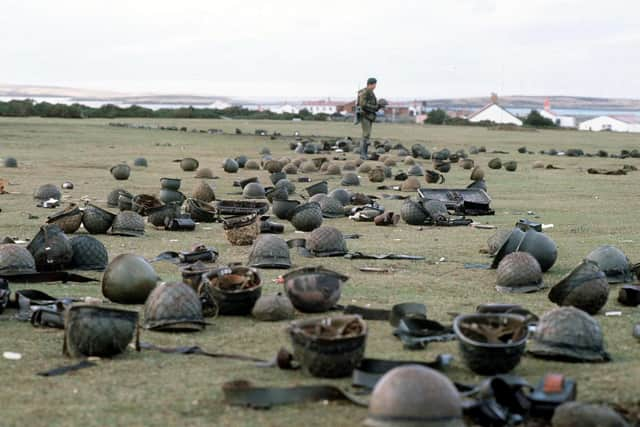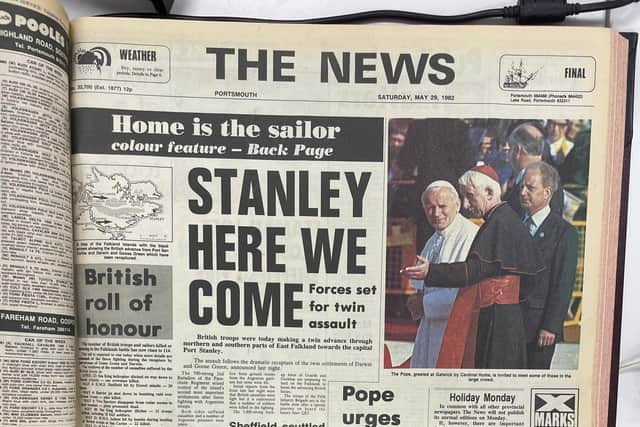Falklands 40: Headlines from The News, Portsmouth on May 29, 1982 as British troops advanced through East Falkand
and live on Freeview channel 276
Stanley here we come, forces set for twin assault
British troops were today making a twin advance through northern and southern parts of East Falkland towards the capital Port Stanley.
The assault follows the dramatic recapture of the twin settlements of Darwin and Goose Green, announced last night.
Advertisement
Hide AdAdvertisement
Hide Ad

The 700-strong 2nd Battalion of the Parachute Regiment seized control of the island’s second most important settlements after fierce fighting with Argentine troops.
Both sides suffered casualties and a number of Argentine prisoners were taken.
Darwin and Goose Green, 20 miles south of the first British bridgehead at Port San Carlos, will probably now be used as a second bridgehead for British troops in the battle to regain the Falklands.
Goose Green, with its grass airstrip, will be used as a base for Harrier jets.
Advertisement
Hide AdAdvertisement
Hide Ad

The main Argentine garrison at Stanley will now face a two-pronged attack by British land forces. While the paratroopers move out from Goose Green and Darwin, thousands of marines and other paratroopers are advancing along a northern route, attacking Argentine positions.
It is thought that Douglas Station and Teal Inlet, 20-miles east of San Carlos, are also back in British hands today.
There are no official reports from the Defence Ministry about the northern movements of troops but it is thought that small companies of Argentine soldiers, numbering about 200, have been captured.
The northern prong of the British attack probably coincided with the retaking of Goose Green and Darwin. The Ministry still has no details about the number of casualties following yesterday’s battle.
Advertisement
Hide AdAdvertisement
Hide AdSheffield scuttled
HMS Sheffield, the Portsmouth destroyer put out of action by a deadly Exocet missile, was scuttled by the Royal Navy, it has been disclosed.
Navy chiefs decided the ship was so badly damaged she would not survive a long tow.
Charges were placed in the ship’s hull by explosives experts with the task force, according to Whitehall sources.
Twenty men died when the Argentine air force launched an attack on the Sheffield, and 24 others were injured.
Advertisement
Hide AdAdvertisement
Hide AdUganda hospital ship only
The task force hospital ship Uganda braved the warplanes to sail into the battle zone to pick up wounded, Argentinian as well as British, from Port San Carlos.
Argentina had earlier alleged that the P&O liner was in the Falkland sound during fighting - implying that she took part in operational activity.
But Ministry of Defence spokesman Mr Ian McDonald categorically denied the charge, which, if true, would involve a breach of the Geneva convention.
‘At no time has Uganda been used in support of military operations,’ he said. ‘She is acting, and will continue to act, as a hospital ship.’
Advertisement
Hide AdAdvertisement
Hide AdTribute to another sea battle
With thoughts of the British task force in mind, Havant will tomorrow pay tribute to the destroyer HMS Havant which was sunk during World War II.
The destroyer, built at Cowes, was sunk by German dive bombers off Dunkirk in the summer of 1940.
Her casualties on that last voyage included one officer and seven ratings killed and 25 wounded. Approximately 25 of the troops she was carrying were also killed or wounded.
The men who died in the Havant are remembered each year at a special service held by members of Havant Royal British Legion.